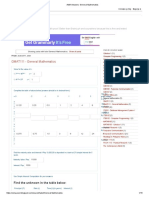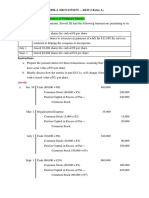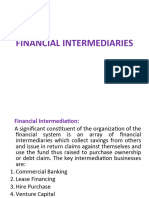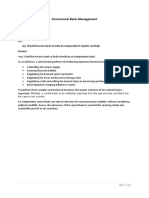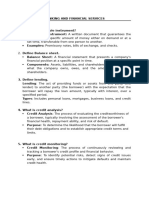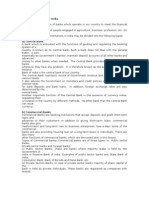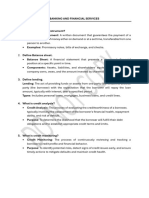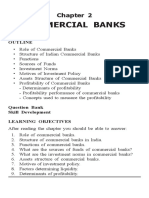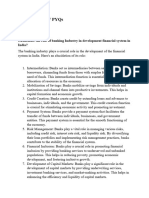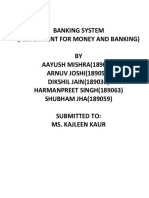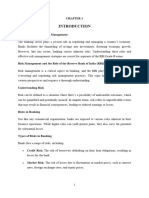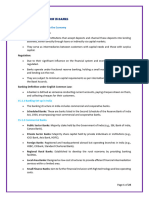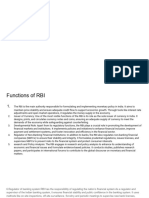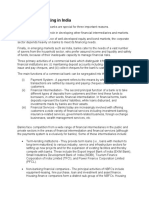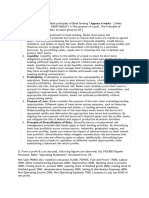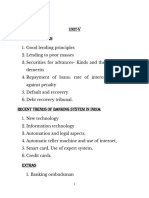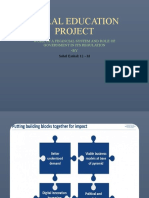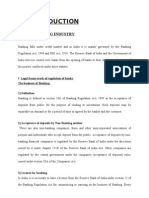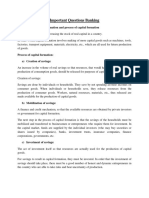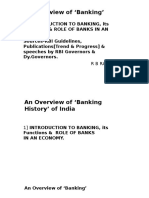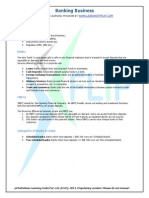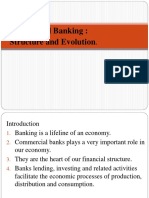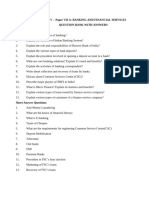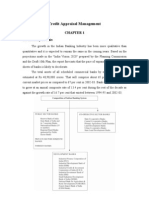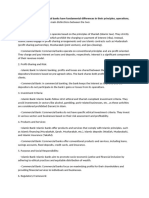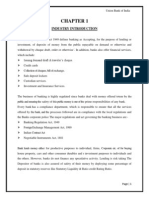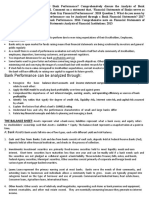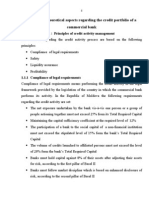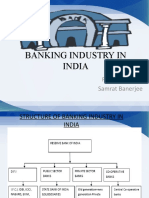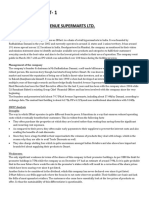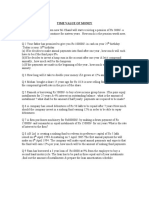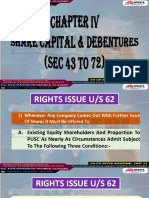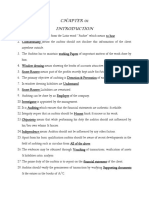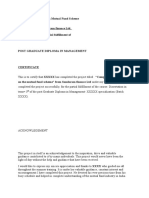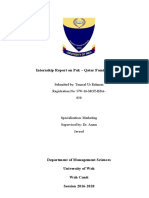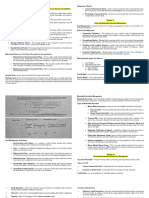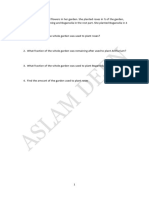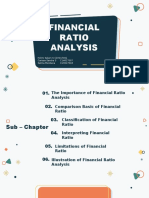Pob
Pob
Uploaded by
gillyhicksCopyright:
Available Formats
Pob
Pob
Uploaded by
gillyhicksOriginal Title
Copyright
Available Formats
Share this document
Did you find this document useful?
Is this content inappropriate?
Copyright:
Available Formats
Pob
Pob
Uploaded by
gillyhicksCopyright:
Available Formats
Difference between money lenders and banks Bank accepts deposits from public, funds so collected are lent
t to needy customers against goods or securities or otherwise. Money Lenders advances his own funds and generally it does not receive public deposits. Bank pays interest on public deposits. Even if a money lender receives deposits, he has no obligation to pay uniform interest on the deposits. Bank deposits are withdrawn by cheques or orders in writing. It is not the case with money lender. Bank can borrow from other banks, market or RBI if required. Money lender generally would not borrow. Bank charges nominal interest rates to the borrowers. Money Lenders normally charges very high rate of interest to the borrowers. Bank are monitored and regulated by RBI. Money Lenders run their own show.
Objectives of AlM It is a dynamic process of Planning, Organizing & Controlling of Assets & Liabilities- their volumes, mixes, maturities, yields and costs in order to maintain liquidity and NII. obJECTIVES An effective Asset Liability Management Technique aims to manage the volume, mix, maturity, rate sensitivity, quality and liquidity of assets and liabilities as a whole so as to attain a predetermined acceptable risk/reward ration.
In banking, asset and liability management is the practice of managing risks that arise due to mismatches between the assets and liabilities (debts and assets) of the bank. Banks face several risks such as the liquidity risk, interest rate risk, credit risk and operational risk. Asset Liability management (ALM) is a tool to manage interest rate risk and liquidity risk faced by banks, other financial services companies and corporations.
ALM is considered as an important tool for monitoring, measuring and managing the market risk of a bank.
It is aimed to stabilize short-term profits, long-term earnings and long-term substance of the bank. The parameters for stabilizing ALM system are:
1. 2. 3.
Net Interest Income (NII) Net Interest Margin (NIM) Economic Equity Ratio
Volatility Product Innovations & Complexities Regulatory Environment Management Recognition
Different types of risk
Risk in a way can be defined as the chance or the probability of loss or damage. In the case of banks, these include credit risk, capital risk, market risk, interest rate risk and the liquidity risk. Since financial institutions like banks have complexities and frequent changes in their operating environments, these kind of risks require more focus. (A) Credit Risk: The risk of counter party failure to meet the payment obligations on the specific date is known as credit risk. Management of this risk is an important challenge for financial institution and failure on this front may lead to failure of banks. It is worthwhile to note that the willingness to pay, which is measured by the character of the party, and the ability to pay need not necessarily go together. In the countries like India, Contract enforcement is another important issue. Delays and loopholes in the legal system significantly affect the ability of the lender to enforce the contract. (B) Capital Risk: Maintenance of adequate capital on a continuous basis is one of the sound aspects of the banking practice. Capital adequacy also focuses on weighted average risk of lending and to that extent, banks are in a position to re-align their portfolios between more risky and less risky asset. (C) Market Risk: It is related to the financial condition, which results from adverse movement in market prices. The problem, in Indian context, is accentuated because many financial institutions acquire bonds and hold it till maturity. When there is a significant increase in the term structure of interest rates, or violent fluctuation in the rate structure, one finds substantial erosion of the value of the securities held. (D) Interest Rate Risk: Interest rate risk is the change in prices of bonds that could occur as a result of change in the rate of interest. It also consider change in impact on interest income due to change in interest rates. Banking industry in India has substantially more issues associated with interest rate risks, which is due to circumstances outside its control. This poses extra challenges to the banking
sector. Over the time Asset-Liability Managers have developed a number of different ways to quantify the risk being taken. These include: i) Maturity: Since it takes into account only the timing of the final principal payment, maturity is considered as approximate measure of risk and in a sense does not quantify risk. ii) Duration: is the weighted average time of all cash flows, with weights being the present values of cash flows. It can again be used to determine the sensivity of prices to change in interest rates. iii) Convexity: Because of a change in market rates and passage of time, duration may not remain constant. With each successive basis point movement downward, bond prices increases at an increasing rate. Similarly, if rate increase, the rate of decline of bond prices declines. This property is called convexity. (E) Liquidity Risk: It is the potential inability to generate adequate cash to cope with a decline in deposits or increase in assets. To a large extent, it is an outcome of mismatch in the maturity patterns of assets and liabilities.
Commercial Banks Among the banking institutions in the organized sector, the commercial banks are the oldest institutions having a wide network of branches, commanding utmost public confidence and having the lions share in the total banking operations. Today, totally 27 banks constitute the strong public sector in Indian commercial banking. The commercial banking structure in India consists of 1) Scheduled Commercial Banks in India 2) Unscheduled Banks in India. Scheduled banks in India constitute of those banks which have been included in the Second Schedule of RBI Act, 1934. RBI in turn includes only those banks in this schedule which satisfy the criteria laid down vide section 42 (6) (a) of the Act. Non scheduled bank in India means a banking company as defined in clause (c) of Section 5 of the Banking Regulation Act, 1949.
Different types of other banks
THE REGIONAL RURAL BANKS RRBs were added to the Indian banking scene since October 1975. It is very closely linked with the commercial banks which has sponsored the proposal to establish it. The rural bank may establish its branches or agencies at any place within the notified area. Cooperative Banks The co-operative banks also perform the basic functions of banking, but differ from the commercial banks in many respects as follows: The commercial banks have been organized either as joint stock companies under the Companies Act 1956. The Co-operative banks have been established under the Co-operative Societies Acts of different states.
National Bank for Agriculture and Rural Development (NABARD) NABARD came into existence on 12th July, 1982. It took over the functions of the erstwhile Agriculture Credit Department, Rural Planning and Credit Cell of the Reserve Bank of India and Agriculture Refinance and Development Corporation. Its subscribed and paid-up capital is 100 crores, contributed by the Central Government and RBI in equal proportion. NABARDs refinance is available with to the State Land Development Banks, State Cooperative Banks, Scheduled Commercial Banks and Regional Rural Banks. In discharging its role as a facilitator for rural prosperity, NABARD is entrusted with:
a) Providing refinance to lending institutions in rural areas. b) Bringing about or promoting institutional development and c) Evaluating, monitoring and inspecting the client banks. Industrial Banks Industrial Banks are engaged in long term loans only for the procurement and placement of fixed assets. National Level: IFCI, ICIC, IDBI, Sate Level: SFC, SIDC
DEVELOPMENT BANKS Another important feature of the structure and organization of Indian Banking System is the establishment of many financial corporations, which provide finance to those sectors of the economy to which commercial banks do not provide finance. It is difficult for commercial banks to participate in the financing of long term requirements of the industry. Some of the developments banks: State Finance Corporations, The Industrial Credit and Investment Corporation, The Industrial Development Bank of India, the Unit Trust of India etc.
How nationalised bank were re-organised The nationalization of banks has restored harmony of interest and softened the intensity of booms and depressions. In a country which has embarked on economic planning based on a socialist pattern of society, it is not only desirable but also necessary to nationalize some important banking institutions to serve the larger interests of the nation. Nationalization of banks began with the passing of the Reserve Bank Act 1948, which became law on the 3rd September, 1948. It was thought desirable to nationalize the bank to ensure greater coordination of monetary, economic and fiscal policies. The second major attempt at nationalization of banking in India was made in 1955 which came to be known as State Bank of India.
Examples Central Bank of India Bank of India Punjab National Bank Bank of Baroda United Commercial bank Dena Bank Canara Bank After the nationalization of banks in India, the branches of the public sector rose to approximately 800% in deposits in deposits and advances took a huge jump by 11,000%
Reasons Equitable distribution of economic power. To provide finance to neglected sectors of agriculture, small scale industries etc. Removal of malpractice. Expansion of banking facilities.
Credit creation Bankers are not merely purveyors of money but in an important sense, they are manufacturers of money. Loans create deposits The function of modern commercial banks is not merely accepting deposits and granting loans but it goes further beyond of Creating money.
Preconditions for Credit Creation There should be certain conditions prevailing in the economy by which the credit creation activity will be effective All economic activities such as production, distribution should take place through banking system. The banking habit among the people should be popular. Cheque should be medium of payments. There should be less dependence on cash transactions
Limitations of Credit Creation Deposits with Commercial Banks. CRR Banking habits of people. Business condition. Opportunities and availability of securities. Leakages in the system Central Bank policy
Objectives of e-banking & Challenges of e-banking It refers to electronic banking where in the entire operations are done by the customers through his computer system by using a code. Even the traditional functions like accepting deposits and granting of loans are done through the electronic media.
Activities under ebanking Pass book Entry. Simultaneous entry of transactions. Home banking. Identification of customers signature. Interbank transfer, intercity transfer. Zero System. Electronic Service.
Benefits of E Banking There is reduction in the cost of banking operations. Better customer relationship. More turnover of banking operations. E banking is faster than traditional banking. Quick remittance of funds. Better bank audit, standing instructions is possible. It helps the central bank to frame the monitory policies. Availability of internet banking
Money replacing plastic money credit cards, debit cards, etc. Credit Card is one of the delivery channels of banking services. Due to advancement of technology and easy accessibility to credit, the credit cards are gaining popularity now a days. Cards are issued to approved clients for purchase of goods or services from authorized merchant establishments on the credit guarantee of issuer of credit card.
Benefits to the card Holder They can purchase goods and services at a large number of merchant outlets upto the inbuilt credit limit without using cash or cheque. Card holder has a period of interest free credit, depending upon the issuing bank and the card scheme. Cash up to a ceiling credit limit is obtainable from the banks branches or ATMs
Disadvantages to Card Holders Often result in over spending. Frauds, due to loss of card in intervening period. Since signatures are already on the cards, forged signatures could cause a loss to card holders.
Various Charges Card issuance charges Depends on the type of credit Card. Annual Charges. Late Payment Charges. EMI Charges. Surrender Charges
Debit cARD A bank issued card that allows its user to access their funds for the purpose of paying for merchandise. A Debit card acts like a credit card, the difference being that funds are immediately taken from the card holders account
Advantages No need to carry cash. Just about every merchant accepts the debit card. Enhanced Security. Reduced cost.
Cheaper Mode of transactions.
Disadvantages Chances of card getting stolen. Unauthorized usage. Risk of overdrawing.
Banc assurance Banks tie up with the Insurance Companies to sell Insurance products to their customers. Profit/Revenue maximization. Cross selling advantage. Retain the customers. All financial transaction in one roof.
Bancassurance can be important source of revenue. With the increased competition and squeezing of interest rates spread, profits are likely to be under pressure. Fee based income can be increased through hawking of risk products like insurance.
RBI role in controlling of commercial banks The Reserve Bank of India (RBI) is the central bank of India and controls the monetary policy of the country.. The institution was established on 1 April 1935 during the British-Raj in accordance with the provisions of the Reserve Bank of India Act, 1934 and plays an important part in the development strategy of the government. Main Functions Monetary Authority. Manager of exchange control. Issuer of currency. Developmental role. Related Functions.
NPA An asset, including a leased asset, becomes non-performing when it ceases to generate income for the bank. A credit facility in respect of which the interest and/or instalment of principal has remained past due for a specified time. (i) interest and /or installment of principal remain overdue for a period of more than 90 days in respect of a Term Loan, (ii) the account remains 'out of order' for a period of more than 90 days, in respect of an overdraft/ cash Credit(OD/CC), (iii) the bill remains overdue for a period of more than 90 days in the case of bills purchased and discounted, (iv) interest and/ or installment of principal remains overdue for two harvest seasons but for a period not exceeding two half years in the case of an advance granted for agricultural purpose, and (v) any amount to be received remains overdue for a period of more than 90 days in respect of other accounts. Sub-standard, Doubtful and Loss Assets
The concept of 'Out of order' for Cash Credit / Overdraft Accounts : An account is treated as 'out of order' (a) When the outstanding balance is more than drawing power or sanctioned limit; or (b) When there are no credits continuously for six months or credits are not enough to cover the interest debited during the same period; or (c) when the stock statement is delayed for 3 months or renewal of limits does not take place or is delayed for 3 months (in case of exceptional cases it can be upto 6 months) even though outstanding balance is within the sanctioned limit / drawing power. The concept of "Overdue": An amount is considered as overdue under any credit facility if it is not paid on the due date fixed by the bank However, some banks made additional provisions to adhere to the 90-day NPA The loan accounts in Banks are classified into four categories. Out of these four categories, the following three categories are considered as NPAs : (a) Sub-standard Assets (b) Doubtful Assets (c) Loss Assets
Difference between modern banking and conventional banking Introduction of social control/ nationalization of banks. Integral part of countrys economy. Mass banking to Niche Banking. Financial Inclusion. Traditional banking to innovative banking. Short term finance to development/need based finance. Security based lending to purpose based lending. Self interest to social cause perspective.
Banking Regulation Act
The Banking Regulation Act was passed as the Banking Companies Act 1949. Banking means accepting for the purpose of lending or investment of deposits of money from public repayable on demand or otherwise and withdrawable by cheque, drafts order or otherwise (5 (i) (b)).cx=Banking company means any company which transacts the business of banking (5(i)(c) Transact banking business in India (5 (i) (e). Demand liabilities are the liabilities which must be met on demand and time liabilities means liabilities which are not demand liabilities (5(i)(f) For banking companies carrying on banking business in India to use at least one word bank, banking, banking company in its name (7). Prohibitions on employments like Chairman, Directors etc (10) Paid up capital, reserves and rules relating to these (11 & 12) Defines business a banking company may be engaged in like borrowing, lockers, letter of credit, traveller cheques, mortgages etc (6(1). Restrictions on business of certain kinds such as trading of goods etc. (8)
Mobile banking
Mobile banking (also known as M-Banking, mbanking, SMS Banking) is a term used for performing balance checks, account transactions, payments, credit applications and other banking transactions through a mobile device such as a mobile phone.
Non-Banking Assets: Non-Banking Assets are those assets which are procured by the bank incase there is a default in a loan, made by a borrower. The asset must be disposed of within 7 years of acquiring it. Due to fall in the value of the assets and deterioration.
Payment of dividends The STACFR decided that the payments of dividends should shift from Quantum of Dividends to Dividend Payout-ratio. o {STACFR: Standing Technical Advisory Committee on Financial Regulations} o (Dividend Payout ratio: The percentage of earnings paid to shareholders in dividends) o (Quantum of Dividend: Every share holder would get 2% of dividends.)
Banks may declare dividends without prior approval of the RBI, but they must comply with the following: 1. Banks should have a CRAR of 11% at least, as well as 2 completed years and the accounting year for which it proposes to declare dividend 2. Net NPA should be less than 3% (NPA: Non-performing assets) 3. The Div. Pay Ratio shall not exceed 33.33%
Loan sanction Loans and Advances A Banking company: o o Cannot grant any loans and advances on the security of its own shares. Cannot enter into any commitment for granting any loans or advances to or on behalf of the following persons; 1. Any of its directors 2. Any firm in which any of its directors is interested as partners, managers, Employees or Guarantors. 3. Any Company of which any of its Directors are interested in any matter.
Recommendation by Narasimham committee Second wave of Liberalisation started with Narsimham Committee Recommendations Reduction of the CRR and SLR The CRR has declined gradually from 15% in 1991 to 5.75% in November 2001 and to 5.5% in December 2001. The SLR was reduced gradually from 38.5% in 1991 to 25% in October 1997. The SLR has remained at this rate until today, while the legal upper limit has stayed at 40% throughout the period
Interest Rate Deregulation The Government started interest rate deregulation in 1992. This led to a complete liberalization of all term deposit rates and lending rates on advances in excess of Rs200,000. The remaining interest rate controls are savings deposit rates and lending rates up to Rs200,000.
Reform of Priority Sector Lending Advances to the priority sectors should be reduced from 40% to 10%. While the targets of 40% imposed on domestic banks and 32% on foreign banks have not changed during the reform period, the burden of this directed lending practice has been gradually reduced by (1) expanding the definition of priority sector lending, and (2) liberalizing lending rates on advances in excess of Rs200,000,
Adoption of Prudential Norms: The RBI issued guidelines in 1992/93 on income recognition, asset classification, and provisioning.
Restructuring of Public Sector Banks Recapitalization Debt Recovery and Bankruptcy Partial Privatization Writing-Off of Bad Debts Setting up of an Asset Reconstruction Company Reduction of Operational Costs
Deregulation of Branch Restrictions The RBI changed its licensing policy in 1992 in order to provide banks with operational autonomy to rationalize their branch networks. Banks were allowed to shift their existing branches within the same locality, open certain types of specialized branches, convert existing nonviable rural branches into satellite offices, spin off business of a branch, and open extension counters and administrative units without prior approval of the RBI. The RBI allowed banks to open branches freely, provided that a bank met the capital adequacy ratio of 8%; earned a net profit for three consecutive years, and had NPAs not exceeding 15% of total outstanding loans. In 1998/99, old and new foreign banks were permitted to open up to 12 branches a year, as against the earlier stipulation of eight branches.
Development in banking sector since 1993 The RBI issued guidelines in 1993 governing the establishment of new private sector banks. The guidelines stated that a new bank needed to maintain minimum paid-up capital of Rs1 billion; list its shares on stock exchanges; fulfill the priority sector lending requirement with modification allowed in the composition of such lending for an initial period of three years; set a ceiling of 1% of total voting rights held by an individual shareholder as stipulated by the Banking Regulation Act of 1949; postpone setting up a subsidiary or mutual fund until at least three years after its establishment, and use modern infrastructural facilities to provide good customer service
In 1994, the Banking Regulation Act of 1949 was amended in order to raise the ceiling of voting rights of an individual shareholder in a private bank from 1% to 10%. The RBI approved six new private sector banks in 1994 The RBI granted an .in principle. approval to three local area banks.
Why Banking Sector Reforms High Regulated Sector Prevalence of High Reserve Requirements Interest Rate Controls Large Allocations to Priority Sector Poor Lending Strategies Lack of Internal Risk Management Low Yields on Government Securities Waiver of Loans on Political Grounds Lack of Competition High Cost of Operations Poor Customer Service Poor Loan Recovery Weak Capital Position Political Interference Lack of Institutional Autonomy Lack of Accountability in Banks Vague Reporting Formats Technology Deficiency
Importance of CRR and SLR Cash Reserves Every listed bank has to maintain a sum equal to at least 5% of its time and demand liabilities as cash Reserves with RBI. o (Demand Liabilities: Liabilities payable on demand. Current deposits, Savings deposits, Short term deposits.) o (Timed Liabilities: Repayable after a specified period. Fixed deposits.)
Statutory Liquidity Ratio Other than the cash reserves, every banking company is suppose to maintain no less than 25% of it time and demand liabilities in cash, gold and other unencumbered securities; In India with RBI.
Investment of various funds in banks No bank can own shares in another company exceeding 30% of the paid up share capital of that company; Or the 30% of its own paid up share capital & reserves. Nor can it do it as a pledgee, mortgagee or absolute owner. (investments in shares is more risky as compared to other securities. Due to volatile financial markets.) (Banks may tend to invest high amounts. Thus due to a increasing market, the government must govern by imposing the 30% rule.) (Pledgee and Mortgage is a bank who has accepted a security to secure its borrowings) (A limit is put out for banks so that they dont loose out heavily in a particular market)
But certain banks such as IFCI, EXIM bank, IRBI, NABARD, NHB, UTI, LIC, GIC, etc. are all exempted from this limit. ( Limit is not kept on a number of prime institutions owned by the government. Mainly due to the fact that they are Development institutions and thus no limits as they raise funds from public)
A banks exposure to capital market in all forms has been restricted to 5% of the total outstanding loans and advances (including commercial papers) as on March 31st of the previous years. Capital Market is very volatile and thus the 5% restriction.
The ceiling of 5% would cover:
1. Direct investment in equity shares and convertible bonds and debentures. 2. Advances against shares for investments in Equity shares, Bonds & Debentures, Units of equity-oriented Mutual funds. 3. Secured and unsecured advances to stock brokers and also guarantees issued on behalf of Stock brokers.
A uniform margin of 40% prescribed on all shares advances/ financing of IPOs and Guarantees.
A minimum cash margin of 20% (within the margin of 40%) prescribed in respect of guarantees issued by banks for above types of advances. There are other ways for banks to invest in securities other than SLR. Such as:
Public Sector Undertakings (PSUs) Financial Institutions Banks Private corporates Subsidiaries joint venture Others Investments in equity and equity like securities
1. Equity: These are investments which have been made in the equity share market.
2. Regional Rural Bank: These are investments in banks which perform function to help those in rural and developing areas, and elevating them from poverty. It is part of the Ministry of Grammena. Every public sector bank must promote at least one RRB. Whereas private banks cannot.
3. Subsidiaries: These are investments in subsidiary companies which are set up by banks for secondary functions to that of the banking primary functions.
4. Venture Capital: This is seed capital or start-up capital that is provided to upcoming entrepreneurs. Entrepreneurs who are starting a business by providing goods or services that are non-existent in the market. This is usually a high risk investment.
5. Units of Equity oriented MFs; This deals with new equity issues. Funds are pooled in by a group of investors. The capital is then handled by a professional Funds Manager, who sees to it that the pooled funds are invested wisely.
6. Advances against shares: This is when shares are taken as a security against loans or advances. This is done only with top rated firms. SARFAESI Act of 2002
The SARFAESI act of 2002, provide banks with the chance of recovering their NPA without court intervention. SARFAESI: Security and Reconstruction of Financial Assets and Enforcement of Security Interest.
The act provides 3 methods in which NPAs can be recovered:
1. Securitization 2. Asset Reconstruction 3. Enforcement of Security without the intervention of the Court
An amount that is less than Rs.1 lakh; or an amount that is less than 20% of the principal or interest, are not applicable to be dealt with under this act.
Liquidity in terms of B/S schedule Liquidity of a company is its ability to pay off its short term debt or obligations.
Maturity pattern of assets should be matched with patterns of liabilities. The procedures laid down to manage the liabilities should be disclosed.
Maturity pattern of foreign currency assets should match patterns of liabilities of:
1. 2. 3. 4. 5.
Items less than or equal to 1 year More than 1 year up to 3 years More than 3 years up to 5 years More than 5 years up to 7 years More than 7 years
Foreign Currency assets should be matched up and disclosed.
The total assets include Rupee assets as well as Foreign Currency assets.
Disclosure Norms for banks balance sheet
The CRAR percentage, which is the ratio of the banks capital to its risk that is expressed in a percentage form, has to be disclosed.
CRAR- Tier 1 (capital) percentage, which consists of equity shares, irredeemable preference shares, minorities interest in equity and goodwill (to write of bad debts); Should be disclosed
CRAR- Tier2 (capital) percentage, which consists of balance under loan loss reserves, subordinated debt instruments, should be disclosed. And Tier 1 capital should not exceed Tier2.
The amount of subordinated debt raised and outstanding as tier 2 capital.
The on balance sheet items are those that affect the total of the balance sheet. Whereas, the off balance sheet items are those that do not affect the total of the balance sheet. These on and off items must be dealt with separately according to its risk on the balance sheet.
The share holding pattern of the balance sheet has to be disclosed, this is for the benefit of the shareholders. Promoters 40%, Public 30%, FI 5%, other institutions 18%, others 7%.
Challenges faced by Indian banks Regulators such as RBI want banks to perform stress tests and scenario analysis of their liquidity risks. The Regulators also want contingency (emergency or unforeseen) plans created, in order to help the bank meet liquidity requirements in times of unforeseen events.
Main challenges faced by the banks in liquidity management are:
1. There are a low number of maturity deposits in the bank due to shrinking of the difference in interests between short term investments and long term investments. Example: A deposit for 1 year maturity may have an interest rate of 7.77%, where as a deposit for 3 year maturity may have an interest of 8.00%. This Low marginal difference between the two can put some customers off.
2. Also due to the decrease in interest rates, customers have resorted to seeking other saving avenues such as Post Office Savings Deposits, Mutual Funds or Equity Investments. This can lead to depletion in long term resources for the bank.
3.
Due to the low interest rates for long term investments, especially in corporate financing, banks are aggressively offering long term maturity loans.
Banks have resolved to investments in long-term government securities, due to low interest rates on advances and lack credit growth. The main issue with this course of action is that the investments are not liquid at all times.
Government securities are subjected to price risk, which can lead to the bank incurring a loss when the selling these securities.
ATM
An automated teller machine (ATM), commonly called a cashpoint. On most modern ATMs, the customer is identified by inserting a plastic ATM card with a magnetic stripe or a plastic smart card with a chip, that contains a unique card number and some security information such as an expiration date or CVVC (CVV). Authentication is provided by the customer entering apersonal identification number (PIN).
Discuss CAR
Capital adequacy ratio is the ratio which determines the capacity of the bank in terms of meeting the time liabilities and other risks such as credit risk, operational risk, etc. In the most simple formulation, a bank's capital is the "cushion" for potential losses, which protects the bank's depositors or other lenders. Banking regulators in most countries define and monitor CAR to protect depositors, thereby maintaining confidence in the banking system.
Balance sheet A Balance sheet is nothing but a statement of assets and liabilities of an individual or a business entity as on a particular date. It is also called as a statement of condition in US and is normally prepared on the last working day of the financial year. In fact, it can be prepared as on any given date also. Many businesses do prepare the balance sheet at regular intervals to ascertain their financial position. It should be remembered that the qualitative aspects of the balance sheet are more important than the quantitative aspects of the balance sheet as the financial strength of any entity depends on the quality of the assets held by it. Many a time, Balance Sheet is compared to the snap shot of a running train as the composition, size and quality of assets undergoes change every moment. Modern B/S and P&L The Profit & Loss account is always prepared for a particular period as against a Balance Sheet which is always struck as on a particular day (point of time). This account gives a clear picture of the income earned and expenditure incurred by a firm during a particular period and the net result ( i.e., Profit earned OR Loss incurred during that period). Again, as in the case of Balance sheet, P&L account is prepared normally at monthly intervals for exercising effective control over the expenditure against the budgeted amount under different heads as a part of MIS.
ASSET An asset is something that is useful or productive to the entrepreneur/business for a period of time (normally more than a year) known as the effective life time or life span of that asset. The asset is always valued in monetary terms (e.g., Indian rupees in our country). So, if we cannot express the value in monetary terms, the same cannot be shown as an asset in the Balance Sheet (e.g., customer service rendered by the employees of a Bank). Another important point to be noted is that whenever the value of the asset is relatively small, the same may be shown as an expenditure and debited to the P&L account and not treated as an asset. The best example for this is a fountain pen worth Rs.250/- purchased for the business. Assets are held by the individual or a business to derive income or satisfaction. LIABILITIES Whatever a business owes to the outside world is known as Liability for the business. Again, expression in the form of monetary terms is required to be done. Accordingly, you cannot treat an employee who is good for nothing (useless) as a liability in a Balance Sheet. From the point of the business, the capital contributed by the proprietor or shareholders is also a form of liability because the business is different from the businessman who has promoted it as per sound accounting principles. As we are adopting the double entry system of book-keeping, assets are always equal to liabilities. CONTINGENT LIABILITIES Whenever there are certain items (e.g., cases pending settlement in the Court of Law) which cannot be recognised as liabilities, but there is a likelihood of the same turning out to be a liability, this fact is shown as Contingent Liability to the outside world in the Balance sheet. However, as we have not yet passed any entries in our Books of Accounts, to recognise the same as liability, it is expressed outside (off) the Balance Sheet. It is expected of everyone going through the Balance Sheet to be vigilant and cautious and try to understand and analyse the Contingent Liabilities of a business and its likely impact on the future profitability and financial health of the concern.
Difference between cash credit and loan 1. Loan account is non-operable ( this means you cannot withdraw the money you have deposited/repaid) 2. Cash-credit account is operable which means you can deposit and withdraw the money subject to certain conditions. 3. C/Cr is normally sanctioned for a period of One year; thereafter, it may be renewed (at the same level, with enhancement or at a reduced level) subject to the satisfaction of the Bank. The date of sanction and date of expiry of a Cash Credit account are very much relevant when identifying it as a performing asset or non-performing asset.
4. Loan account is closed once for all after the repayments are over. There is no question of renewal; if you have to purchase another asset, a new loan account has to be put through. 5. Cash credit account is operated on the principle of limit sanctioned or drawing power is lower. 6. Cash credit facility is provided for meeting the working capital requirements of businessmen/industrialists. 7. Agricultural Cash credit is provided to agriculturists to enable them to raise crops; however, at present the same facility is provided through Kissan Credit Cards. 8. A borrower enjoying C/Cr facility is expected to submit stock statements at regular intervals. A stock statement is a statement containing the description, quantity of the item held, the rate per unit and the total value of the stocks being hypothecated/pledged to the Bank. The guiding principle for the Banker to value the stocks for arriving at the Drawing Power is Cost Price or Market Price whichever is lower. 9. If stock statements are not submitted in time, penal interest may be charged by the Bank. 10. A borrower enjoying C/Cr facility may be permitted to overdraw his C/Cr account whenever there are exigencies and the borrower requests the Banker to help him out to tide over the difficulties for a short period. 11. A C/cr account may become out-of-order in some cases. 12. A C/Cr account becomes overdue on the expiry of the sanction period and the sanction limit becomes Zero. 13. A C/Cr account is required to be reviewed by the Banker every now and then. Such review is a must before renewal 14. Whether a particular borrower is using the C/Cr facility is judged by the turnover in the account. The borrower is expected to remit his surplus cash to the account and withdraw/issue cheques as and when required to his suppliers. 15. The total of debit entries in a Cash Credit account during a given period is known as DEBIT SUMMATIONS and similarly, the total of credit transactions during the same period is called as credit summations. The difference between DR and CR summations is the balance in the account as on the date. During the days of manual banking, the summations were used as a tool to ensure the arithmetical accuracy of books of accounts maintained by the ledger keepers. 16. The interest debited to the Cash Credit account has to be repaid or remitted by the borrower (C/Cr account holder) in cash so as to make the account a Performing Asset.
Online Banking
Online banking (or Internet banking) allows customers to conduct financial transactions on a secure website operated by their bank. Online banking solutions have many features and capabilities in common, but traditionally also have some that are application specific. The common features fall broadly into several categories
Transactional (e.g., performing a financial transaction such as an account to account transfer, paying a bill, wire transfer, apply for a loan, new account, etc.) Payments to third parties, including bill payments and telegraphic/wire transfers Funds transfers between a customer's own transactional account and savings accounts Investment purchase or sale Loan applications and transactions, such as repayments of enrollments
Non-transactional (e.g., online statements, cheque links, browsing, chat) Viewing recent transactions Downloading bank statements, for example in PDF format Viewing images of paid cheques
Financial Institution Administration Management of multiple users having varying levels of authority Transaction approval process
Important sources of income for bank RBI guidelines provide that the the policy of income recognition in Banks has to be objective and based on the record of recovery. Internationally income from non-performing assets (NPA) is not recognised on accrual basis but is booked as income only when it is actually received. Therefore, the banks should not charge and take to income account interest on any
(a) Interest on advances against term deposits, NSCs, IVPs, KVPs and Life policies may be taken to income account on the due date, provided adequate margin is available in the accounts. (b) Fees and commissions earned by the banks as a result of re-negotiations or rescheduling of outstanding debts should be recognised on an accrual basis over the period of time covered by the re-negotiated or rescheduled extension of credit.
Voting rights of shareholders Annual Report Schedule I Advantages of CBS Types of Investment in B/S
CPG in banking sector Retail Banking and its Advantages Different types of schedule 13 & 14 & 16 Benefits of computerisation Imaginary B/S and P&L P&L Appropriation A/c
You might also like
- AMA Answers - General MathematicsDocument15 pagesAMA Answers - General MathematicsDaniel Tom Chuy Darm100% (2)
- Tugas Ch. 15 - Week 10Document9 pagesTugas Ch. 15 - Week 10Lafidan Rizata FebiolaNo ratings yet
- DuPont Case StudyDocument1 pageDuPont Case Studyjlee174No ratings yet
- Pcu - Prelim - Intacc 3 - Part 1Document7 pagesPcu - Prelim - Intacc 3 - Part 1Renalyn Paras50% (4)
- Financial Intermediation BusinessDocument96 pagesFinancial Intermediation BusinessRoba AbeyuNo ratings yet
- Banking Law & Practice Week 2Document36 pagesBanking Law & Practice Week 2King LaysNo ratings yet
- Commercial Bank ManagementDocument8 pagesCommercial Bank ManagementShilpika ShettyNo ratings yet
- Commercial Banking Imp Questions and AnswersDocument12 pagesCommercial Banking Imp Questions and AnswersSHUBHAM STAR PatilNo ratings yet
- BFS_M0DELDocument25 pagesBFS_M0DELAzgarNo ratings yet
- Overview of Lending Activity: by Dr. Ashok K. DubeyDocument19 pagesOverview of Lending Activity: by Dr. Ashok K. DubeySmitha R AcharyaNo ratings yet
- Summary Banking BusinessDocument37 pagesSummary Banking Businesssahil sharmaNo ratings yet
- Introduction To BankingDocument59 pagesIntroduction To Bankingshahyashr100% (1)
- Fodder Material For Phase 2 For SEBI Grade A 2020: WWW - Edutap.Co - in Hello@Edutap - Co.InDocument13 pagesFodder Material For Phase 2 For SEBI Grade A 2020: WWW - Edutap.Co - in Hello@Edutap - Co.InMega MindNo ratings yet
- Banking System in IndiaDocument9 pagesBanking System in IndiaBhavesh LimaniNo ratings yet
- Introduction To BankingDocument38 pagesIntroduction To BankingNusrat papiyaNo ratings yet
- Introduction of Bank and BankingDocument12 pagesIntroduction of Bank and BankingAtia IbnatNo ratings yet
- RitiDocument21 pagesRitiRiti NepaliaNo ratings yet
- How Is CRR Used As A Tool of Credit ControlDocument14 pagesHow Is CRR Used As A Tool of Credit ControlHimangini SinghNo ratings yet
- A Manual On Non Banking Financial Institutions: 9. Anti Money Laundering StandardsDocument143 pagesA Manual On Non Banking Financial Institutions: 9. Anti Money Laundering StandardsRahul JagwaniNo ratings yet
- Commercial BankingDocument14 pagesCommercial BankingSudheer Kumar SNo ratings yet
- BFS M0delDocument22 pagesBFS M0delSwethaNo ratings yet
- 180 Sample-Chapter PDFDocument15 pages180 Sample-Chapter PDFhanumanthaiahgowdaNo ratings yet
- Banking Law PYQDocument11 pagesBanking Law PYQxakij19914No ratings yet
- Bank Lending EnvironmentDocument7 pagesBank Lending EnvironmentMoses OlabodeNo ratings yet
- Banking SystemDocument10 pagesBanking SystemVaishnavi JhaNo ratings yet
- ReportDocument31 pagesReportJay SharmaNo ratings yet
- Unit 02Document3 pagesUnit 02shreeyauday044No ratings yet
- Unit 1 PRINCIPLES OF INSURANCE & BANKINGDocument124 pagesUnit 1 PRINCIPLES OF INSURANCE & BANKINGsomangy GaggarNo ratings yet
- Mod 3 - Chapter 15 - 18 Regulation and ComplianceDocument28 pagesMod 3 - Chapter 15 - 18 Regulation and ComplianceSURBHI SHARMANo ratings yet
- Role of RBIDocument16 pagesRole of RBInayna.16907No ratings yet
- Commercial Banking in IndiaDocument12 pagesCommercial Banking in IndiamahajandenikaNo ratings yet
- Functions of Commercial Banks ReportDocument14 pagesFunctions of Commercial Banks ReportAryan Khan50% (2)
- Capital AdequacyDocument11 pagesCapital AdequacyTezan RajkumarNo ratings yet
- Principles of Bank Lending & Priority Sector LendingDocument22 pagesPrinciples of Bank Lending & Priority Sector LendingSheejaVarghese100% (8)
- Commercial Bankes in Sri LankaDocument15 pagesCommercial Bankes in Sri LankaRaashed RamzanNo ratings yet
- Winter ProjectDocument25 pagesWinter ProjectKishan gotiNo ratings yet
- SUGGESTED QUESTIONS AnswersDocument21 pagesSUGGESTED QUESTIONS AnswersDevansh KhaitanNo ratings yet
- UNIT 5 - Lending by BanksDocument85 pagesUNIT 5 - Lending by BanksAum KarNo ratings yet
- Moral Education Project: Work of A Financial System and Role of Government in Its Regulation - BYDocument17 pagesMoral Education Project: Work of A Financial System and Role of Government in Its Regulation - BYshamilNo ratings yet
- Bank of IndiaDocument36 pagesBank of IndiaRuchi_Gulati_4764No ratings yet
- A) Central Bank: Types of Commercial Banks: Commercial Banks Are of Three Types I.e., Public SectorDocument4 pagesA) Central Bank: Types of Commercial Banks: Commercial Banks Are of Three Types I.e., Public Sectorks211185No ratings yet
- Important Questions BankingDocument21 pagesImportant Questions BankingAshutosh AgalNo ratings yet
- 2) Overview of BankingDocument48 pages2) Overview of BankingAltamashNo ratings yet
- Summary - Banking Business PDFDocument37 pagesSummary - Banking Business PDFMonika AgarwalNo ratings yet
- Commercial Bank PDFDocument22 pagesCommercial Bank PDFA ThakurNo ratings yet
- A Project Report On The Surat PeopleDocument131 pagesA Project Report On The Surat PeopleHimanshu MistryNo ratings yet
- Banking Structure and EvolutionDocument11 pagesBanking Structure and EvolutionChinedu JosephNo ratings yet
- Banking Financial Services Management - Unit 1: Overview of Indian Banking SystemDocument64 pagesBanking Financial Services Management - Unit 1: Overview of Indian Banking SystemtkashvinNo ratings yet
- Credit Management Overview and Principles of LendingDocument55 pagesCredit Management Overview and Principles of LendingShilpa Grover100% (4)
- Banking and Financial Services QB With AnswersDocument34 pagesBanking and Financial Services QB With AnswersRAVI ABHINo ratings yet
- Literature ReviewDocument4 pagesLiterature ReviewJimmy JonesNo ratings yet
- Mathi ProjectDocument22 pagesMathi ProjectAnju JayanthanNo ratings yet
- Islamic Banks and Commercial Banks Have Fundamental Differences in Their Principles, Operations, and Objectives.Document4 pagesIslamic Banks and Commercial Banks Have Fundamental Differences in Their Principles, Operations, and Objectives.Md Fazle RabbiNo ratings yet
- BTLP Unit-1Document102 pagesBTLP Unit-1Dr.Satish RadhakrishnanNo ratings yet
- Tools For Managing Liquidity in The Money MarketDocument17 pagesTools For Managing Liquidity in The Money MarketSagar Mv67% (3)
- Union Bank of IndiaDocument58 pagesUnion Bank of Indiadivyesh_variaNo ratings yet
- FINANCIAL SYSTEM. Lect.4Document3 pagesFINANCIAL SYSTEM. Lect.4Blue StoneNo ratings yet
- Commercial Banking in IndiaDocument32 pagesCommercial Banking in IndiaShaifali ChauhanNo ratings yet
- Proiectul Meu de CursDocument28 pagesProiectul Meu de CursNicorici-Railean IonelaNo ratings yet
- Summary - Banking Business PDFDocument37 pagesSummary - Banking Business PDFsatyakidutta007No ratings yet
- Banking Industry in India: Presented By: Samrat BanerjeeDocument23 pagesBanking Industry in India: Presented By: Samrat BanerjeeSohini KarNo ratings yet
- Bank Fundamentals: An Introduction to the World of Finance and BankingFrom EverandBank Fundamentals: An Introduction to the World of Finance and BankingRating: 4.5 out of 5 stars4.5/5 (4)
- ACCT 10001: Accounting Reports & Analysis - Lecture 9 Illustration: BudgetingDocument4 pagesACCT 10001: Accounting Reports & Analysis - Lecture 9 Illustration: BudgetingBáchHợpNo ratings yet
- Research Insight-1: Company Name - Avenue Supermarts LTDDocument2 pagesResearch Insight-1: Company Name - Avenue Supermarts LTDSaksham KalraNo ratings yet
- QuestionsDocument2 pagesQuestionsnitesh jain100% (1)
- SCM AssignmentDocument37 pagesSCM AssignmentAaradhya DixitNo ratings yet
- Robin Haft Trust v. Commissioner of Internal Revenue, 510 F.2d 43, 1st Cir. (1975)Document7 pagesRobin Haft Trust v. Commissioner of Internal Revenue, 510 F.2d 43, 1st Cir. (1975)Scribd Government DocsNo ratings yet
- Chapter 4 Share CapitalDocument208 pagesChapter 4 Share CapitalAkash MalikNo ratings yet
- AccelyaDocument220 pagesAccelyaShyamasundaraNo ratings yet
- Auditing MCQ QuestionsDocument20 pagesAuditing MCQ QuestionssalmanNo ratings yet
- Wild Shaw (8th Ed.) Connect GuideDocument494 pagesWild Shaw (8th Ed.) Connect GuideSrikar RootsNo ratings yet
- Cpa Reviewer in TaxationDocument10 pagesCpa Reviewer in TaxationmaeNo ratings yet
- Comparative Analysis On Mutual Fund Scheme MBA ProjectDocument83 pagesComparative Analysis On Mutual Fund Scheme MBA Projectvivek kumar100% (1)
- Cesim Global Challenge Introduction 112021Document28 pagesCesim Global Challenge Introduction 112021shaymae ameurNo ratings yet
- This Study Resource Was Shared Via: Solution 23-2 Answer DDocument5 pagesThis Study Resource Was Shared Via: Solution 23-2 Answer DDummy GoogleNo ratings yet
- SouthernCopper-AR 2022Document110 pagesSouthernCopper-AR 2022wigidas889No ratings yet
- Ratio Analysis Review QuestionsDocument5 pagesRatio Analysis Review QuestionsPASTORYNo ratings yet
- Pak Qatar Family Takaful FinalDocument62 pagesPak Qatar Family Takaful FinalHamza HameedNo ratings yet
- Cash and Cash EquivalentsDocument3 pagesCash and Cash EquivalentsRheea de los SantosNo ratings yet
- Business Finance Adm Module 1 Quarter 2 Week 1 To 3 Introduction To InvestmentsDocument28 pagesBusiness Finance Adm Module 1 Quarter 2 Week 1 To 3 Introduction To InvestmentsJudy Ann VillanuevaNo ratings yet
- ABNL Annual Report 2011-12Document222 pagesABNL Annual Report 2011-12Gundeep Singh KapoorNo ratings yet
- Paper - 5: Advanced Accounting Questions Answer The Following (Give Adequate Working Notes in Support of Your Answer)Document56 pagesPaper - 5: Advanced Accounting Questions Answer The Following (Give Adequate Working Notes in Support of Your Answer)Basant OjhaNo ratings yet
- Question ADV GMDocument6 pagesQuestion ADV GMsherlockNo ratings yet
- FM Major Sub Reviewer FinalsDocument11 pagesFM Major Sub Reviewer FinalsrsamedenillaNo ratings yet
- Balance Sheet of Indiabulls - in Rs. Cr.Document3 pagesBalance Sheet of Indiabulls - in Rs. Cr.MubeenNo ratings yet
- British Parents Bought 3Bn of Toys in 2011: Lego Leads The WayDocument36 pagesBritish Parents Bought 3Bn of Toys in 2011: Lego Leads The WayCity A.M.No ratings yet
- Maths Seminar PaperDocument20 pagesMaths Seminar Paperilmairshad2008No ratings yet
- Financial Ratio Analysis: Helmi Salam S C1H017001 Carissa Sandra S C1H017007 Salma Meidiana C1H017018Document26 pagesFinancial Ratio Analysis: Helmi Salam S C1H017001 Carissa Sandra S C1H017007 Salma Meidiana C1H017018salma_meiNo ratings yet
